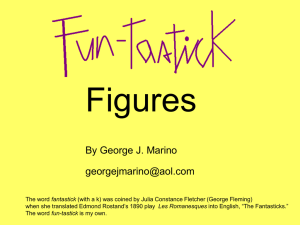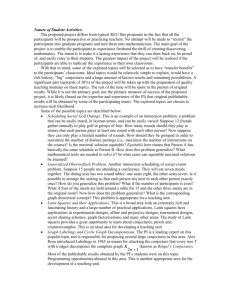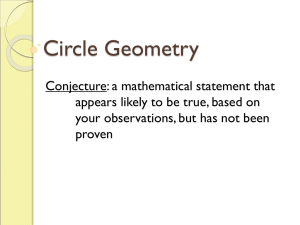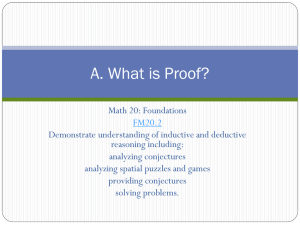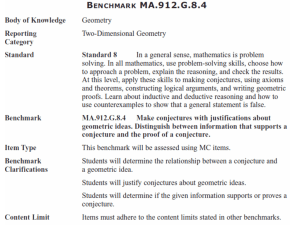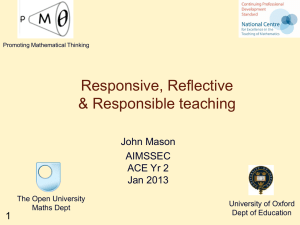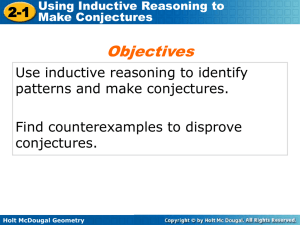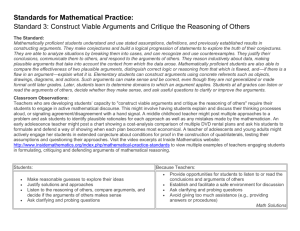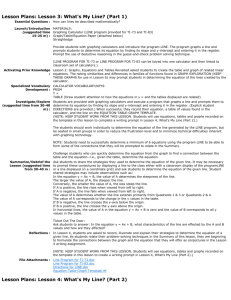4 Making Conjectures About Mathematics
advertisement
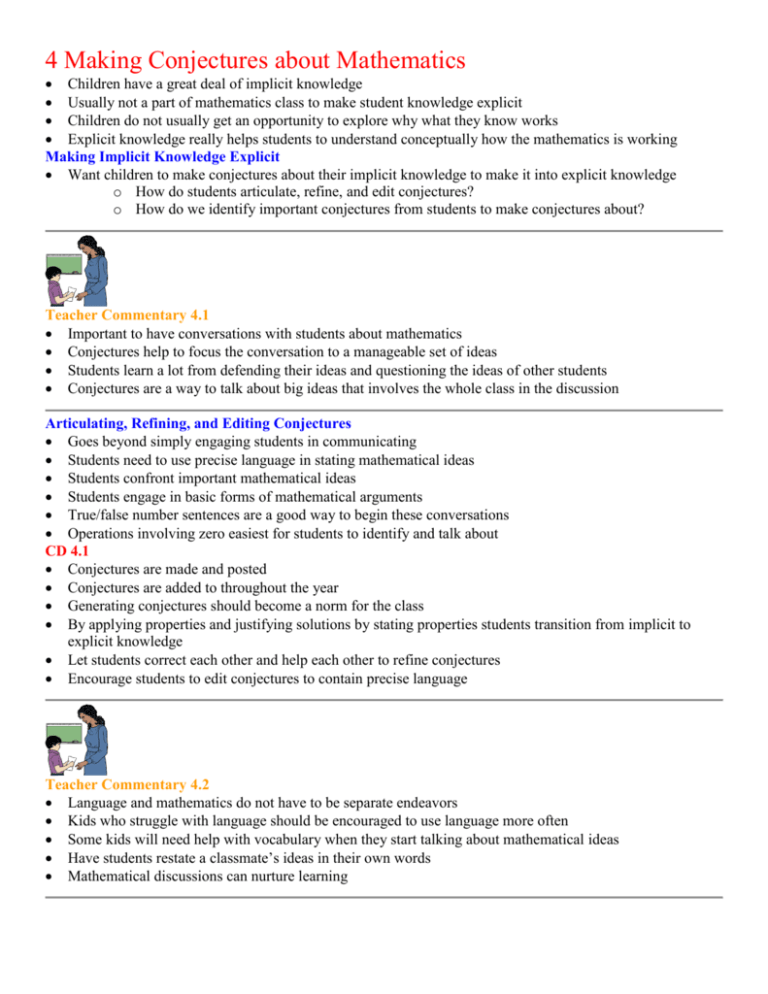
4 Making Conjectures about Mathematics Children have a great deal of implicit knowledge Usually not a part of mathematics class to make student knowledge explicit Children do not usually get an opportunity to explore why what they know works Explicit knowledge really helps students to understand conceptually how the mathematics is working Making Implicit Knowledge Explicit Want children to make conjectures about their implicit knowledge to make it into explicit knowledge o How do students articulate, refine, and edit conjectures? o How do we identify important conjectures from students to make conjectures about? ABCDEFGHIJKLMNOPQRSTUVWXYZ Teacher Commentary 4.1 Important to have conversations with students about mathematics Conjectures help to focus the conversation to a manageable set of ideas Students learn a lot from defending their ideas and questioning the ideas of other students Conjectures are a way to talk about big ideas that involves the whole class in the discussion Articulating, Refining, and Editing Conjectures Goes beyond simply engaging students in communicating Students need to use precise language in stating mathematical ideas Students confront important mathematical ideas Students engage in basic forms of mathematical arguments True/false number sentences are a good way to begin these conversations Operations involving zero easiest for students to identify and talk about CD 4.1 Conjectures are made and posted Conjectures are added to throughout the year Generating conjectures should become a norm for the class By applying properties and justifying solutions by stating properties students transition from implicit to explicit knowledge Let students correct each other and help each other to refine conjectures Encourage students to edit conjectures to contain precise language ABCDEFGHIJKLMNOPQRSTUVWXYZ Teacher Commentary 4.2 Language and mathematics do not have to be separate endeavors Kids who struggle with language should be encouraged to use language more often Some kids will need help with vocabulary when they start talking about mathematical ideas Have students restate a classmate’s ideas in their own words Mathematical discussions can nurture learning Editing Conjectures Initial description of a conjecture will often include several examples Students who disagree should give specific examples to say why a conjecture needs to be stated more clearly When conjectures seem ambiguous, editing can help to make them more precise CD 4.2 ABCDEFGHIJKLMNOPQRSTUVWXYZ Teacher Commentary 4.3 Writing down a conjecture is only the beginning of the discussion Still need to discuss the big ideas present Need to ask questions: o Do we know these big ideas will always work? o How will this big idea help you? o Why is it important for us to think about this? o Why would knowing you can switch the order of numbers to add help you to do math? o Can you think of when that might help you? o How is it going to help you with your arithmetic? Putting the conjecture on the wall is not the end of the discussion either Some Conjectures about Basic Properties of Number Operations More than just making big ideas explicit Want students to make conjectures because they explore important mathematical ideas Conjecture discussions empower students to learn new mathematics, to solve problems, and to understand the mathematics they are currently learning and doing See table 4.1 for a list of basic properties of number operations p. 54-55 Conjectures initially written in natural language Large numbers tend to draw out conjectures better than smaller numbers Conjectures 1, 4, and 7 have two similar statements o Only difference is the order of the numbers is reversed o Once one conjecture is established the other follows from it Conjectures in table are related in interesting and important ways o Parallels between addition and subtraction of zero and multiplication and division by one o As students discuss these conjectures it is valuable for them to see these relations Extending conjectures like a + 0 + 0 + 0 + 0 = a does not really add to the basic conjecture even though it is true If extended conjectures come up they can be interesting to discuss and can provide some good insight Be wary of special case conjectures – conjectures that are true only for a particular case or isolated set of cases Want to be economical in writing conjectures Conjectures can be combined to form new conjectures See table 4.2 p. 56 Invalid Conjectures Sometimes conjectures may sound good initially, but are generally untrue Look a lot like valid conjectures Come from over-generalizations See table 4.3 p. 57 More Conjectures Will be discussed in later chapters ABCDEFGHIJKLMNOPQRSTUVWXYZ Teacher Commentary 4.4 Students thought there were no numbers smaller than zero Lager number minus smaller number gave them zero Money to the rescue! Writing and talking about conjectures solidifies and clarifies knowledge Generating conjectures is an ongoing process A wide variety of conjectures will be made Some will be quite different from ones explored here Some conjectures which seem true at first blush may prove false under other circumstances o Adding two numbers always gives a bigger number only true for positive numbers not true if one number is zero o Decisions have to be made of how to proceed Can let the conjecture stand – not generally a good idea as it causes problems for the students later on Teacher can edit the conjecture without going into a detailed explanation Teacher can take the time to go into a brief or detailed explanation – requires a major time commitment Need to deal positively with conjectures that are not true Want the children to take responsibility for deciding the truthfulness of conjectures Teacher is generally obligated to guide students into correcting untruthful conjectures Ok to post false conjecture as long as the truth of the conjecture is in doubt and is eventually determined to be false Important to edit conjectures – keep edits as evidence of students progress in understanding a concept Definitions Frequently proposed by students Distinction between definition and conjecture is there is no way to justify a definition Definitions are somewhat arbitrary Making this distinction may be very informative Students struggle with defining mathematical terms they are familiar with Students need to articulate and edit definitions too Rules for Carrying Out Procedures Students often propose algorithm as conjecture Even though we use these rules as a convenience, they are for generating answers not for increasing understanding Probably best to steer students away from these ideas Conjectures about Even and Odd Numbers When you add two odd numbers, you et an even number Conjectures about even and odd numbers offer a good opportunity to examine what it means to justify a conjecture Summary: Types of Conjectures that Students Make Conjectures about fundamental properties of number operations o Describe basic properties of numbers and operations on them o Most important conjectures for students’ learning of arithmetic and algebra o Addition conjectures of this type chapters 8 and 9 Conjectures about classes of numbers o Include conjectures about even and odd numbers o Conjectures about factors and divisibility rules Descriptions of procedures o Rules for carrying out specific computational procedures o Descriptions of procedures involve outcomes of calculations o Not usually amenable to being expressed in terms of open sentences General descriptions of outcomes of calculations o Notions like Addition and multiplication result in larger numbers Subtraction and division result in lower numbers o Quite global conjectures o If a is grater than b and c is greater than d, then a + c is greater than b + d Definitions o Should not be considered as conjectures o Definitions cannot be justified o They are true by definition ABCDEFGHIJKLMNOPQRSTUVWXYZ Teacher Commentary 4.5 Conjectures can be challenging for special education students Can do workbook pages well, but do not understand concepts behind rote operations May not get right the first time, but after editing they do get it For first and 2nd graders, this is amazing
